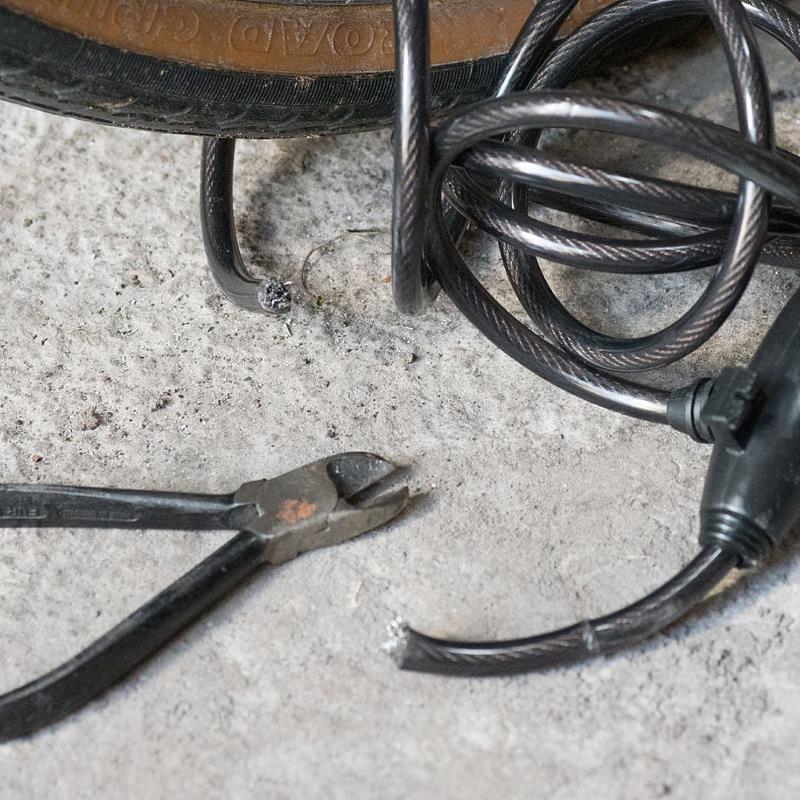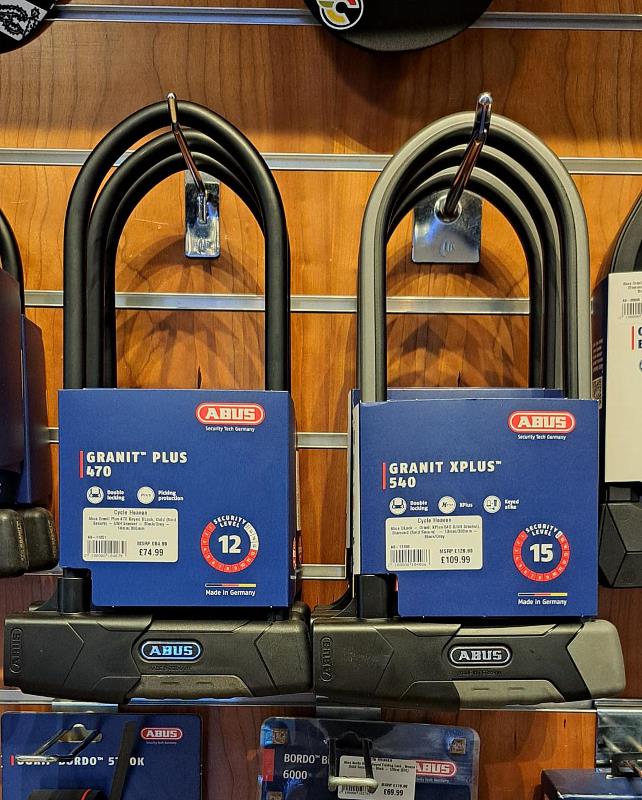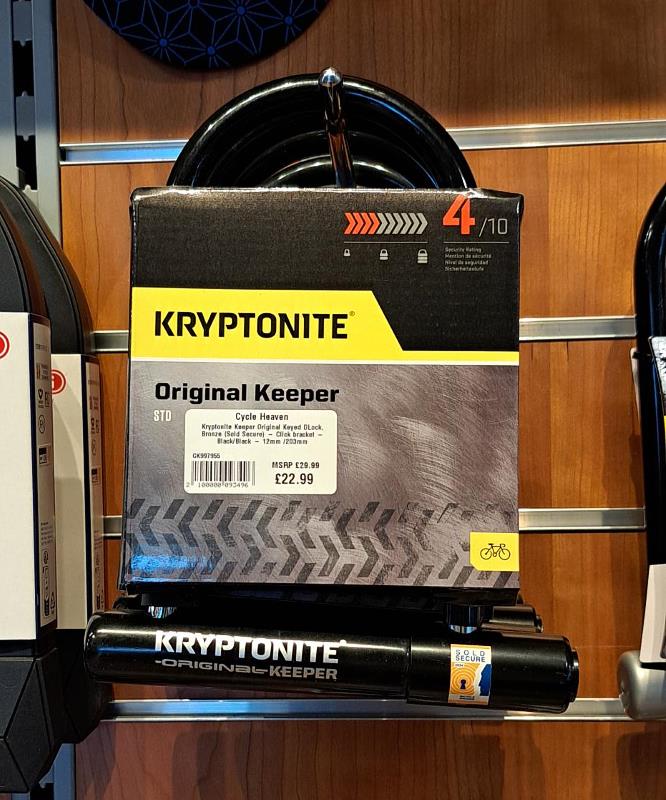One bike is stolen every 7 seconds in the UK (bike theft statistics, 2024), and given that bikes are so easy for people to steal and ride away on, security is vital...

With cycling being more popular than ever, the second-hand market growing and online platforms making it easier to sell, theft is more common.
It sucks to see your hard-earned bike disappear in an instant and we know from experience that the psychological effect can be substantial. NEVER leave your bike unsecured – even if it’s just for a couple of minutes while you pop into a shop. It takes seconds to steal an unlocked bicycle.
We’ve covered everything we know about cycling security below, but if you need to jump to a specific section here are the quick links:
- Where bikes get stolen
- Common ways bike locks are compromised
- How to select the right bike lock for you bike?
- Primary Cycle Locks: Our Top Picks
- Other security options
- What to do if your bike is stolen
Bike security is so much more than a bike lock. We’ll cover locks later, but while a good lock is essential, how you use that lock is just as important, and you also have to be mindful about when and where you lock your bike. Let’s look at this part first…
Where bikes get stolen
If you regularly leave your bike in the same place, any place, the risk can be higher as often such places are watched by thieves. Parking areas in public places such as stations, schools, hospitals or shopping streets are also thief magnets and therefore higher risk - especially locations with lower visiblity. But by far the most common place for a bike to get stolen is from a shed, yard, or garage at home, with thefts mostly happening at night.
What all these places have in common is that bikes are regularly parked there in the same place for the same amount of time each day or night, so it’s easier for thieves to plan.
At Home
It’s not enough to simply put your bike in a locked shed or garage. At Cycle Heaven we recommend locking your bike with a good lock to something immovable – whether it’s kept inside, or out in the yard. The best option is something that has been designed specifically for the job – a ground or wall anchor. These are well engineered and solidly built to be securely fixed, easy to attach your bike lock to, and to withstand a determined attack.
At Cycle Heaven we sell wall anchors in a variety of shapes, sizes and prices, so talk to us about your requirements, but these two are the most popular:
Best Budget Wall Anchor
Hiplok ANKR Mini is a discreet and affordable wall mount at only £18.99. Combined with a high-quality lock it should be sufficient for most regular bikes with a value of below £1,000.
Best All-Round Wall Anchor
Abus WBA75 is still compact, but with an enhanced security rating and can be wall or floor mounted. At £54.99. it’s our most popular model.
Out and About
When out and about, it’s best to look for a busy, well-lit place with CCTV cameras if possible. Avoid locations that are more secluded as public exposure is one of the best deterrents to thieves. Choose a sturdy, immovable object to lock them up too, ideally a purpose made bike rack, or some sturdy railings. If there are lots of bikes, it’s best to go for a space towards the middle, as bikes are more likely to be stolen from the end of rows. Never lock you bike to a drain pipe as these are easily shattered – be they made of plastic or cast-iron.

If you are leaving your bike for extended periods (over 1 hour) lock the frame and both wheels to the bike rack. To do this effectively you will need a primary and a secondary lock or extension cable. If you have only one lock, be sure to lock it so as to secure both the frame and at least one wheel. In this instance, the front wheel is probably best, as the rear is harder to remove.
If just nipping out to the shops, a lighter bike lock may be sufficient, as a big heavy steel lock can be inconvenient. While generally there is a link between weight and additional security, there are still some lightweight, but fairly secure locks available.
Common ways bike locks are compromised
- How are thieves getting through bike locks?
Relatively cheap, and easy to carry around, manual bolt cutters will cut through nearly all cable locks. Hacksaws and hammers are also used to cut and smash through poorer quality bike locks. A good quality ‘D-lock’ will defeat these tools.
Portable, battery powered angle grinders are another matter, and will cut through most D-locks. But these are noisy and intrusive, so your best protection is to park your bike somewhere public with lots of passers-by. We do now sell locks that will defeat angle grinders, but they don’t come cheap.
- What are thieves looking for when choosing bikes to steal?
Opportunist thieves are most likely carrying tools hidden in a coat pocket, these people are looking for any bikes secured with weak locks, puny chains and padlocks. Chances are, that if your bike is secured with a high quality lock on a crowded bike rack, they will go for something else, as there will almost inevitably be other bikes that are badly secured!
As well as easy access, thieves are more likely to target flashy performance models or e-bikes because of their higher value. If your bike is more of a day-to-day workhorse and you’re not overly worried about its appearance, then a bit of judiciously applied gaffer or electrical tape can make it look far less desirable! It will also have the advantage of protecting your bike’s paintwork.
The lock itself: How to select the right bike lock for you bike?
Sold Secure
Most of the locks that we sell are certified by Sold Secure (SS), which is an agency recognised by insurance companies that tests and rates locks. It uses a Bronze, Silver, Gold, and Diamond metric to indicate how long a lock can withstand an attack, though in practice insurance providers will insist that any high-quality bike have a Gold or Diamond rated lock to be covered.
Manufacturer’s Ratings
If you are not getting your bike insured, manufacturers also have their own ratings, which can be helpful when comparing locks within a brand, but as they all have their own standards, do not translate across lock brands.
Your Primary Bike Lock
Your primary lock is the main lock that you use to lock your bike frame to the bike rack. Use Sold Secure as a guide for your primary lock – SS Diamond for e-bikes and bikes over £1,000; SS Gold for bikes worth £500 - £1,000. SS Silver will be sufficient at the bottom of this range if you’re not looking to insure your bike. SS Bronze is only good for old, and in this instance, helpfully tatty looking bikes!
The good news is that we now sell SS diamond rated locks that will defeat angle grinders.
‘U’ or ‘D’ Bike Locks are still your best bet
U locks are still the most secure locks, however they differ enormously both in cost, quality and resistance to attack, so again, use Sold Secure as your guide as unlike other types, all the D-Locks that we sell have a SS rating. Although a D-lock can be bulky, it’s quick and simple to use, which makes it more likely that it’s going to get used!
How much should I spend on a primary lock?
Our advice is to spend at least 10% of the value of your bike on your primary lock. SS diamond rated locks that will defeat angle grinders come at a price (£250-£300), but given this 10% rule, a good investment for almost all of the e-bikes that we sell. We also sell a SS bronze rated D-lock for £22.99.
Are Folding Locks any good?
Folding locks are also a popular primary lock solution. Some are not so bulky as D-locks, but the lighter and more compact versions don’t attract high SS ratings. The ones that do unfortunately, are as big and heavy as D-locks, so for high end bikes D-locks are a better bet. Where they do come into play, is when you are looking for something of medium security to use on lower value bikes.
Are chains and cables effective?
No. Not on their own. We would only recommend chain and cable locks for very low value bikes or as secondary locks (see below). We do offer some highly rated and very heavy-duty chain locks made for motorcycles which can be kept at fixed locations such as home or work, but these are not really practically portable by bike!
Secondary Bike Locks
There are always times when a second lock is useful - either for extra overall security, to stop your wheels from being stolen, or to secure accessories such as a helmet, to your bike. Chains and cables are good for this and we always stock a good selection. We also offer some D-locks with an extra cable which can be threaded through your wheels and then looped back onto the primary lock itself.
Primary Cycle Locks: Our Top Picks
Best Standard D-Locks

SS Diamond: Abus Granit XPlus 540 – from £109.99*
SS Gold: Abus Granit Plus 470 – from £74.99*
SS Silver: Abus Granit 460 – from £49.99*
Abus D-locks have always been the benchmark. High security, but also well engineered and durable mechanisms that are reliable and easy to use. Their USH bracket is also the best – easy to fit, quick to use and the only bracket that easily fits to low-step frames. Whilst other brands may be cheaper, Abus locks are definitely worth the extra investment. Essentially the same design at three levels of security.
Best Anti-Angle Grinder Lock for E-bikes

SS Diamond: Hiplock D1000 – from £249.99*
This beast will destroy the blades of the favourite tool of professional thieves. Pricey, but justified by what it’s protecting. A must for e-bikes and cargo bikes.
Best Budget D-Lock

SS Bronze: Kryptonite Original Keeper – from £22.99*
At under £25, this is so much better than a similarly priced cable or chain and will do fine for a scruffy old ‘clunker’ or ‘pub bike.’ Such bikes might not be worth much, until you lose one and realise that they are very much worth protecting!
Best compact D-Lock

SS Gold: Kryptonite Evolution Mini 7 with 4’ Flex Cable – from £59.99*
Compact D-locks have the advantage of being smaller and lighter, but can offer higher security as they leave less prising space between the rack, bike frame and the lock. For extra pennies this comes with a handy extension cable to secure your wheels and accessories.
Best Folding Lock

No SS rating: Abus Bordo 6055K Lite – from £49.99*
Selected for its lightness and portability. These are very compact with a bracket that fits to a bottle cage mount. Good enough just for short stays with regular bikes or as a secondary lock.
Other security options:
Trackers
A GPS tracker can be fitted to your bike. This means that you can always track the location of your bike on your phone, as well as receive a tamper alert if someone attempts to move your bike. These devices may not prevent a theft, but will increase the chances of recovery. They are best used with e-bikes where they can be fitted inside the motor housing and run off the battery. They are less effective on manual bikes as mounting them discreetly can be a problem, as can be the power source. For manual bikes you are probably better off putting the extra money towards a higher security lock.
Insurance
Insurance is a very good idea for high value bikes. Under most insurance policies, you won’t be covered for bike theft if the lock isn’t approved. Sold Secure Gold is the minimum standard for many insurers and SS Diamond is even better. Pop in store to pick up a leaflet to unlock 30 days free cover with LAKA bicycle insurance.
Keeping Records
Keep a record of your bike’s frame number as it could be important evidence in the event of a theft. It’s usually stamped on the underside of the bottom bracket shell (which is the part of the frame between the pedals), although many companies record this on a weatherproof barcoded sticker, so look out for this too. The best cycle retailers will also have recorded it on your account and if your bike came from Cycle Heaven, you will also see it on a sticker attached to your owner’s manual. Take some photos of your bike too for good measure.
BikeRegister
We recommend that you register your bike with BikeRegister. BikeRegister is the UK's national cycle database and the leading online bicycle identification initiative. It enables owners to be reunited with their bikes if they are stolen and recovered. BikeRegister is used by every Police Force and enables police officers to easily trace ownership of recovered, stolen or lost bikes. You can register using your frame number for free, but it’s also advisable to buy their security marking kit too which allows you to apply a permanent and unique reference number to the frame - either through a tamper resistant sticker or permanent etching. We sell these kits at Cycle Heaven.
In the event of a theft, what should I do if my bike is stolen?
Report it to the Police
If you are unlucky enough to have your bike stolen it is important to report as soon as possible. Go into the local police station and give as much detail as possible. It is easy to be cynical about the efficacy of police efforts around bike theft, but there are good reasons to make the effort. First, there is always a chance of recovery and every year thousands of bikes are recovered and remain un-reunited with their owners! (This is more likely to happen if you have registered your bike). Second, the local police have a good knowledge of the area and repeat offenders and could well spot someone on your bike when out on patrol. Finally, reported crimes add to the crime figures and the police will only direct resources towards cycle crime if those figures justify it.
Make sure you get a crime reference number which helps you keep track of your case and is used for insurance claims. Provide as much detail as possible, including photos if you have them, frame number and bike make/type.
If CCTV footage was available, try to gain it (approach the shop nearby and ask). Are there any witnesses such as people working in shops overlooking the site or other regular cyclist commuters who may have seen something? If there was a GPS tracker hidden on the bike, keep a track of the location info and share it with the police.
Need some extra advice?
If you still need a bit more help in selecting the right lock for your bike, visit us at one of our stores and our knowledgeable, friendly team with show you some more options and how they work in practice!
Visit us:
- 31 Hospital Fields Road, Fulford, York, YO10 4FS
- York Railway Station, Station Road, York, YO24 1AY
- 2 Bishopthorpe Road, York, YO23 1JJ
*Prices are accurate at time of blog being published, September 2024.